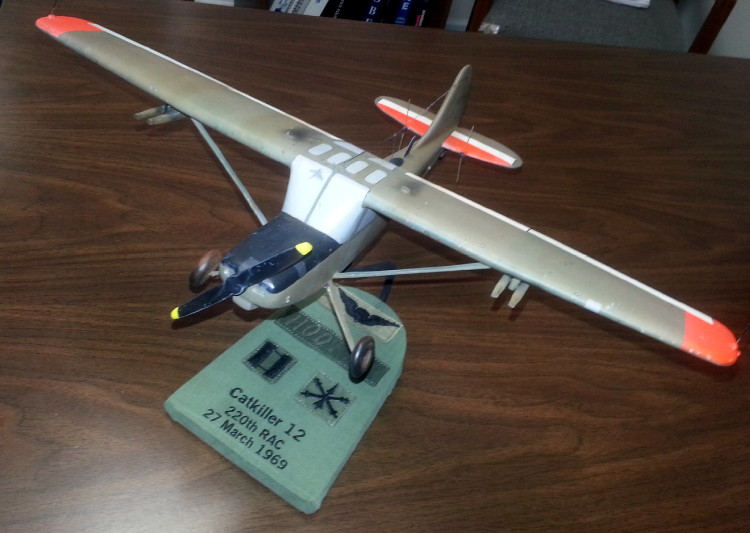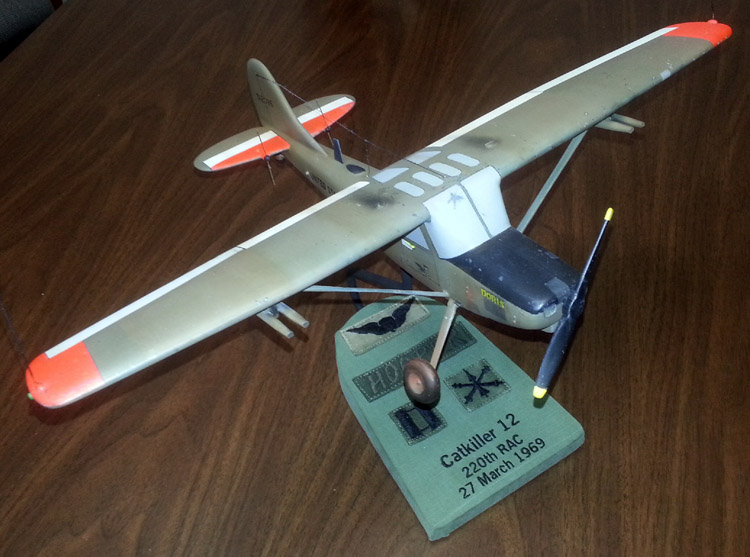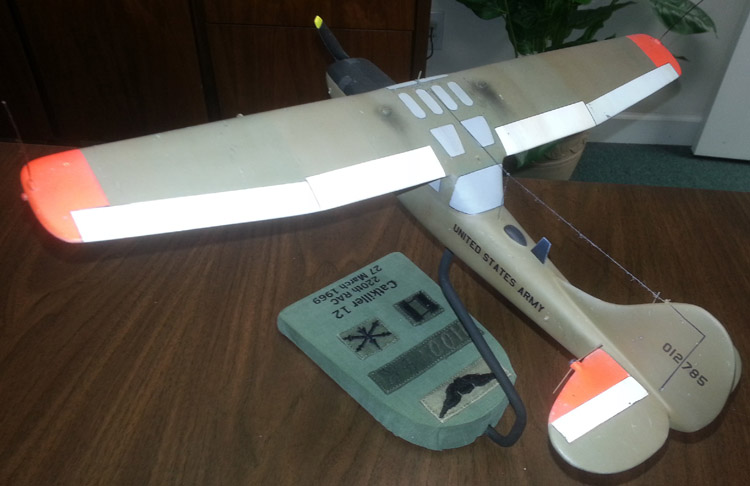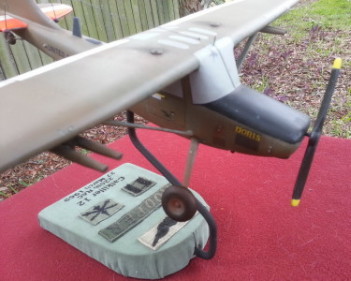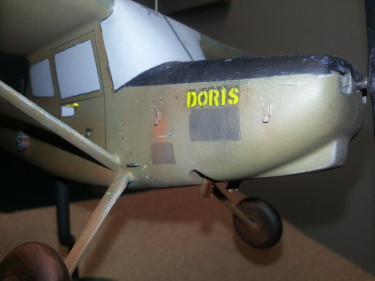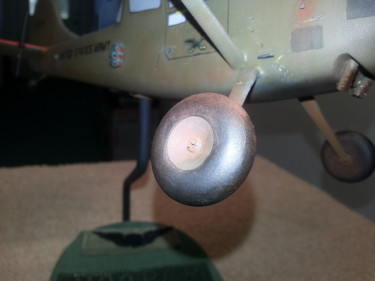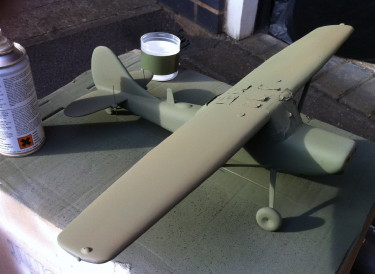A MIRACLE OF THE INTERNET, FOUR DECADES LATER
by
Jim Hooper
INTRODUCTION:
There are moments when the miracle of the Internet lands smack on top of you. The odds of my brother Bill listening to a life-changing moment in his life four decades after the event would surely be close to zero without it. When Gary Huber contacted me with the following I was astonished. When I made contact with Jim Paschall, I knew this was a piece of history worthy of special attention. The sequence of events and message traffic provide the details.
Jim Hooper [author of A Hundred Feet Over Hell]
THE MIRACLE:
Gary Huber:
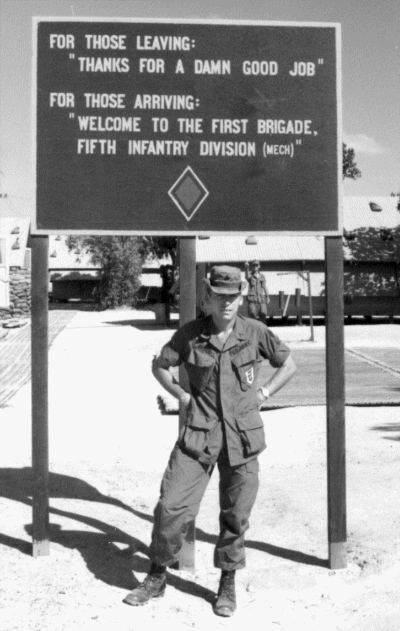
I was looking for some events (rocket attacks, counter battery missions, etc.) at the "Guns Of The DMZ" website for a friend´s VA claim. The 8th Bn, 4th Field Artillery at Dong Ha was the 175 mm artillery battalion, that [the Catkillers] often used to destroy the NVA´s Russian-built 130 mm guns and other high value targets north of the DMZ. At any rate, I just happened to check the guest book archives which often provide leads and right at the top of the page, Archived Guest Messages, the second entry was:"Name: Jim B. Paschall LTC USAF Ret. Message Date: 02/01/10 E-Mail Address: jimfarmersc@gmail.com Comments: Sometime in the Summer of 69 I overheard, and taped, the MAYDAY call of Katkiller 12 who announced that his arm was shot off. I would share the tape with the pilot and Whiskey if I had contact."I immediately recognized the KatKiller 12 as Catkiller-12 and had an "ah—ha!" moment, knowing that it was a significant moment for Bill and perhaps details long forgotten might be soon come to light when he heard his Mayday call. I also wondered if I could/should contact Jim Paschall as some 18 months had passed since he had made his Guest Book entry, but he answered my email and you have the rest of the story.
The actual mayday call recording from Jim Paschall, a USAF F-4D pilot, flying out of Thailand, is a shortened (4 minutes, 12 seconds) version to remove unnecessary audio but contains all pertinent traffic:
From Bill Hooper to Jim Paschall:
"Dear Jim,
Saturday I got a call from my brother Jim, giving me the heads up on your posting found by Gary Huber (married to our cousin). My first response was, "Well, perhaps we are about to find out how good my memory was." Reflecting on that day, I have often wondered how our lives are much determined by fate. As a brief history to that recording, I had been watching a build up of some very large NVA installations for a week or two and, though well camouflaged, after flying over the same real estate 6 or 7 hours a day you got pretty sensitive any changes on the ground. My problem was the weather. Though it was getting to the end of the monsoons the weather was still not suitable for running the air (we were all TACA qualified) that would be needed. While we did have 8" artillery available, the topography worked against that solution. The targets were on the north face a steep east-west ridge line and the artillery was located southeast of the target, so the rounds would be landing down slope making it tough to penetrate the cover. Since I needed air to effectively engage the target I waited for the weather to clear.
On the 26th the weather broke and I decided to engage the next day if it held. When it did, as the section commander, I switched assignments and took the mission that covered that area (there goes that pesky fate thing). Not to belabor the point, the mission started out well with lots of secondaries and lots of ground fire. We were using the 8 inch air—bursts to suppress that ground fire between air strikes. With the last of four rounds exploded, I drifted in over the target (and a bit too low, I might add) for my back seat to get a better look. A a piece of shrapnel from one of the rounds impacted my front windscreen and hit my right biceps. I was in slow flight (about 85 knots) and my hand was knocked off the stick. At first I didn´t even know I was hit but knew I had lost control of the plane but didn´t know why. The credit for our survival goes entirely to my back seat, Capt Bill Norton, who regained enough control to keep us in the air long enough for me to regain my wits. I got us turned south and headed for Dong Ha, got the plane trimmed up and put out my Mayday. By that time the arm had turned a deep blue black, had no feeling, so I was convinced of its loss. Fortunately I was wrong on that count.
Editor''s Note: A break in Bill's email to Jim Paschall is necessary to show three sequenced photos taken at Dong Ha by Jim Lawrence, a Marine Aviator from VMO-6, who just happened to be in his aircraft as the incident unfolded. Although not clear, the photos show where Bill landed that day and where he began to receive immediate medical attention and evacuation to Quang Tri:
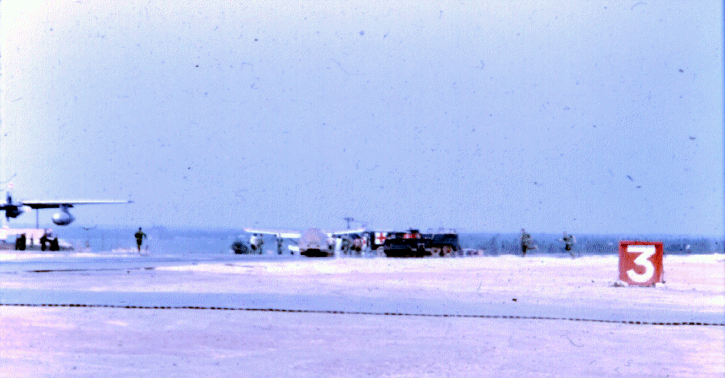
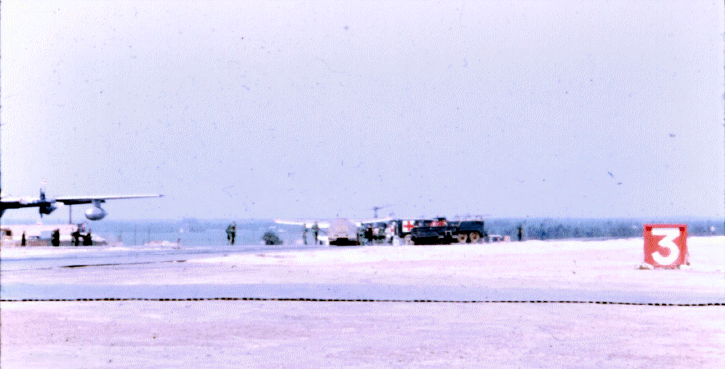
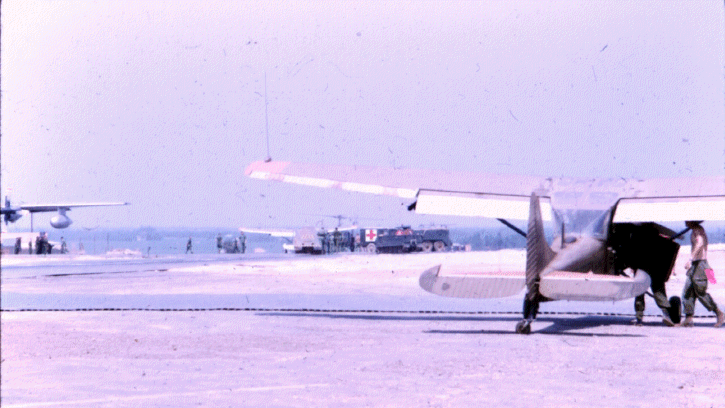
So here we are, two guys 42 years later coming together because you cared enough to post a message and a most detailed researcher, Gary Huber, found your posting and he cared enough to pass it on. Remarkable when you contemplate the whole thing. So if you get the chance to forward the recording I will owe you dinner if you ever visit Florida. I trust and hope all is well with you and your family.
All the best,
Bill Hooper
Once upon a time, Catkiller 12"
Editor''s Note: Captain William W. "Bill" Norton was the backseat artillery adjuster that day, and although now deceased his calmness in the midst of this event and follow-on actions clearly support Bill Hooper's statement that their survival was directly and substantially influenced by this cool-thinking backseater. He helped Bill by giving him time to recover before landing. Bill Norton earned the Distinguished Flying Cross for his actions that day:
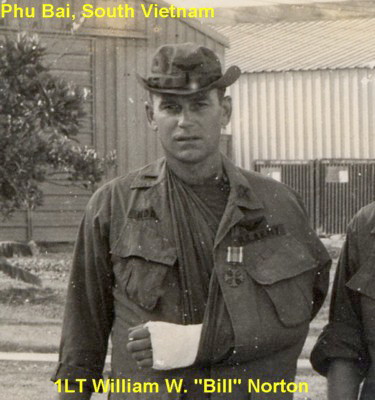
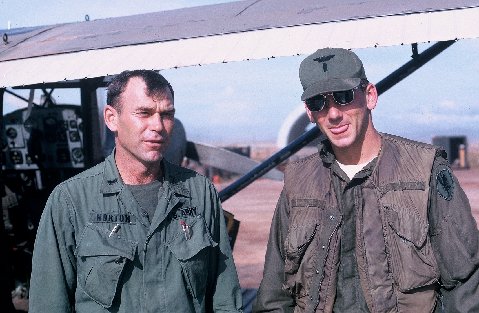
William W. Norton, Captain, Artillery, Aerial Observer
108th Artillery Group, Sundowner Whiskey
From Jim Paschall: Gentlemen; INCOMING:
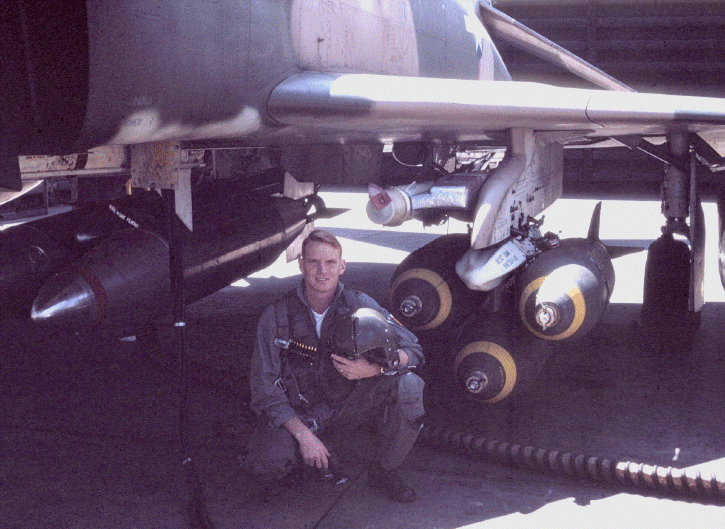
What a wonderful trip down memory lane it has been for the past two weeks. An itch that has been persistent for 42 years is satiated. When I first heard Bill's call over Guard Channel, I was mesmerized by the horror of his situation and the helplessness of my inability to assist. He disappeared off of my electronic encounter with him — leaving me to wonder all these years as to his fate. His voice was permanently scored on the hard-drive of my brain. Due to the efforts of Gary and Jim I was overwhelmed to hear that voice once again and to learn that my worst fears were for naught.
Sometimes you eat the Bear; sometimes, the Bear eats you.
I read the book. I am impressed!
thanks,
Jim Paschall
Gary Huber to Jim Paschall and Hooper brothers:
Jim,
Thank you for the note; I am so happy that you and Bill were able to reconnect under much more peaceful circumstances. I also appreciate Jim´s efforts to get Bill´s story published. Fate and marriage has intertwined our experiences in an unimaginable way. When I married their cousin, Linda, shortly after returning to CONUS after a tour in Germany I knew little about Jim and Bill. When I went to Vietnam and served in Quang Tri, I knew nothing of Bill´s support of 5th Infantry Division ground units. And then nearly thirty-three years later I run across Jim´s request for more information from participants of the Battle of Kinh Mon and we connect. This latest happening, seeing your post on the 8th Bn 4th FA Regiment web-site, is just fate or good luck.
I believe each of us has gotten some closure, I know I have.
Best regards,
CSM(r) Gary Huber - AB9M
Reflection of Jim B. Paschall on the events surrounding the flight of Catkiller 12 on 27 March 1969:
On the afternoon of 27 March 1969 I took off from Udorn RTAFB as number 2 in a two ship F-4D flight on a scheduled combat mission in Laos with a Nail FAC. We were each carrying ten (10) 500# slick bombs. This was a Flight Lead checkout mission for Decor 1.
Not long after takeoff, I turned a cassette tape recorder on to record 30 minutes of the mission. I usually timed the turn on point to record the actual "engaged" portion of the mission but on this occasion I turned it on early as there was a lot of chatter on GUARD channel revolving around an attempt to rescue HOBO 63 who was shot down on the 060 degree radial off of CH 89 at 35 NM. His parachute was in sight and the downed pilot was talking to HOBO 62 overhead. Decor flight was busy refueling with tanker Peach 32 at this time. While we were on the tanker, Oxford (F4C Recc) came up on GUARD channel announcing that he was over the Plain de Jars and was hit. Sandy 5 contacted him with a safe route to fly and announced he was on his way to assist if needed. Well, it was getting exciting early on in the mission and I was sure we were going to be involved in a rescue mission. My guy in the back seat indicated to me that we were sure getting a lot of hits lately.
We finished our refueling and flew East over Laos while checking in with Invert for mission following. After cycling through Sycamore we wound up back on Invert with Crown 2 for SAR of HOBO 63.
Not long after we checked in with the SAR controllers—up on GUARD channel comes "Catkiller 12."
I never got around to turning the cassette tape over for the next 30 minutes of recording because we got involved in the SAR for HOBO 63. As I recall we finally put our slick bombs on the downed pilot´s location to stop the gomers from climbing up the hill where he was located. I believe the SAR was successful. Also, as a tidbit, Oxford made it back to Udorn.
Jim Paschall
8/27/2011
FORTY–FOUR YEARS LATER, A BROTHERLY GIFT OF EXTRAORDINARY TRAVEL AND AFFIRMATION:
As a preface to the tale of having to customize a “customized” model of my brother Bill’s Birddog, a reminder of what many of us originally hoped for might be appropriate. I’ll begin with passages taken from the Griffin Aerospace website. (Emphasis is mine.)
Are you tired of the same old “stock”, mass–produced planes available anywhere? If you can't find what you’re looking for, our company is your most reliable custom model manufacturer. Griffin specializes in one–of–a–kind aircraft replica. Take note that your personalized models are orders built according to your specification and results will be as good as the information you have provided at the time of order—photos must show closeup of details to be able to replicat. The better pictures, the better results. Our artist’s work [is] based on your photos.
There was the first challenge. Although I had a photo Charlie Finch had taken after Bill’s last mission, the tail number was not visible. This prompted an all–hands bulletin (leaving my brother out of the loop) for anyone who might remember it. Don Ricks compared Finch’s photo with all the shots in his collection, trying to match the unique dents and scratches to others. It didn’t take long for his eagle eye to shoot down my suggestions. Crew chief Dennis Jenkins recognized the aircraft, but didn’t remember the serial number; he did, however, explain that those maintaining the O–1s were allowed to paint girlfriends’ names on the cowlings — thus Doris — but didn’t recall whose girlfriend it was. As far as the road runner on the door, he had no idea of its significance. Ed Miler (Catkiller 6) reminded me that Road Runner 6 was the call sign of Jack Mullen, CO of the 212th CSAB, but when I contacted Col Mullen, he could shed no light on it. Jack Bentley (Catkiller 17) and Ray Caryl (Catkiller 32/42) both came back with a shot from a May 1969 article in Aviation Digest that showed Doris in flight and the all–important number clearly visible. Ray also referred me to his classmate Bobby Wooley’s book, The Birddog’s Tale, which showed that 50–12785 was assigned to the 220th RAC in February 1968. Not long thereafter, Marine back–seater Lanny Thorne sent photos of himself refuelling Doris at Dong Ha. They may not have included the tail number, but they did show Doris’s paint scheme. I now had enough info to place the order, emphasizing that I wanted the model to show the effects of sun, wear and tear from fuel hoses dragged over the leading edges of the wings, dents and dings and dust. No problem, Mr Griffin told me.
The first problem was the long delay between ordering and any hint that the promised delivery date would be met. And then, when the first couple of examples emerged, the realization that they bore only superficial resemblance to what had been promised. A succession of emails followed, outlining what I expected, with Mr Griffin assuring me all would be done as requested. It became clear such was not the case. A demand that my order be cancelled was acknowledged, then, a month later, I was informed that it had already been completed. The photos, however, revealed it a gloss finish, lettering and numbering that were not proportionally correct, and none of the weathered, dusty appearance I’d insisted on. It was not acceptable. A refund was promised, but none was forthcoming. Convinced it was yet another guarantee unlikely to be fulfilled, I grudgingly took delivery.
By now, Steve Crump, publisher of my book Koevoet, volunteered to turn his experienced modeller’s hand to bringing Doris up to snuff. And for that tale, I turn the story over to him.
Jim Hooper
Catkiller Nights! A Thousand and One Uses of Olive Drab Paint!
By Steve Crump, publisher GG Books
It was when working with author Jim Hooper on the third edition of his best–selling book Koevoet that I was introduced to Doris. At the time, I was building a model of a Casspir, the type of mine protected vehicle he had spent months in while embedded with a South African counter–insurgency unit, and asked Jim for clarification on the details from his vast collection of photos. (Yes, I’m one of those sad people that stick plastic together for a hobby!)
Somewhere along the line, Jim mentioned that he had acquired a model of a Cessna Birddog for his brother, Bill. Jim wasn’t happy with the Birddog’s finish and asked if I would it the modeller’s once over. Which is how Doris came to be looking up at me from my modeller’s bench. It was very clear that what we had here was a machined and neatly presented Cessna, which needed some dirtying down. It certainly didn’t look like it had been hurtling up and down dusty runways in Vietnam and dodging AA fire! Jim lent me A Hundred Feet of Hell and I learned of the Catkillers and their deeds of derring–do! Even as an ex–Royal Marine, I’d have thought twice about spotting in full view of the enemy in a slow, under–powered Cessna! But whilst reading the story the full enormity of what lay ahead hit me. This wasn’t just me banging something together for my own interest and pleasure. This model was for a veteran the aviator that had flown the aircraft. No pressure then!
So where to begin? The first job was to strip down the presented finish so it could be reworked. After carefully photographing every angle of the model and measuring off features such as the hi–vis panels and glazing, I set to with a light grade sand paper to remove markings, etc . When I had a neutral surface, Doris was given an overall coat of light gray. Once dry, a coat of acrylic Humbrol olive drab was applied. Since the Catkiller Cessna’s had to endure the South–Asian sun, I applied a light coat of dark earth over the olive drab, which gave the upper surfaces a slightly bleached look. On the undersides, a light dusting of grass green was sprayed; all of this aimed at giving depth and contrast.
Set aside again for the paint to harden, it then occurred to that there was nothing upon which the weathering could be affixed — panel lines, indentations, grooves, etc. With plastic kits, the moulding process replicates panels, rivets and so on. All of which enable the model maker to suggest depth, contrast and so on. Doris, was completely bare, not a line on her! I needed something to add detail and so I dived into the spares box to add cowling latches, fuel caps and fuselage lifting lugs. Now at least there was something upon which to hang washes, chipping and dry–brushing, all of which would serve to give Doris a lived–in look; one that would suggest many days above the Vietnamese jungle!
With the latches and lugs in place, I applied a coat of acrylic black on the cowling and gave the fuselage a further dark earth finish. I now started to think how I would add the panel lines. Using a combination of pencils and ink pens, the elevator panels for the main wings and the tail planes were added. As were the doors and engine hatches. This was harrowing — a slip of the hand would mean instant disaster, but after a long night and with a steady eye, the resultant effect seemed to do the trick. Phew, that was a relief, because the more I read of Captain Bill Hooper’s exploits and the fact that he had been wounded in action whilst flying a Birddog, just upped the ante to produce a good result even more!
To apply the hi–vis bands, I masked off the requisite areas and sprayed on a fluorescent orange colour. I then did the same for the adjacent white panels. Unfortunately the orange seemed to ‘bleed’ into the white and so I had to re–do some of the panels. This meant further delay as I waited for the paint to harden!!
White spirit washes were used to tone down some of the colours and to give a satisfactory mute finish. A mixed combination of grey, green and black washes were used and an oily wash effect positioned around the fuel caps. Once dry, a light dark earth mixture was dry–brushed over the upper surfaces to, again, suggest sun bleaching. Over this, light gray was dry–brushed to create a lighter effect and bring out detail.
I was now entering probably the trickiest phase of the job — replicating the glazing. I had masked off the general area of the Plexiglas glazing so that once I had finished with the olive drab and dark earth applications, I would have the general outline of the cockpit glazing to work from. This was the case and so I now set about making good the glazing with a hand painted grey. This sent me both stir–crazy and cross eyed! The finish wasn’t that good and I was struggling to get a good, straight, demarcation between the grey glazing and the dark earth fuselage. I then decided that the best way to address matters here was to use pens to scribe a fine defining line around each piece of glazing — eg. doors, cockpit windscreen, the four top glazing apertures etc. This seemed to work and now Doris was looking a bit tidier! The damage that occurred to the windscreen, when Doris was hit by shrapnel, was drawn on with pens and pencils.
Some initial chipping was now undertaken. This meant using pencils to replicate foreign object contact / damage on the leading edges, wheel struts etc. This was quite easy to apply and I stuck to my usual maxim of ‘less is best.’ I had painted the propeller a matt black, with yellow edging, and once this was dry, I applied chipping here too, focusing on the propellers leading edge.
What I thought was to be a straightforward exercise in sourcing UNITED STATES ARMY decals for the fuselage was to become a nightmare. I could find none that were of the required size. There were some on the various decal websites that looked as they were the job, but once ordered and received I found they were too small in length and font size. I now began to panic. I began posting on model making sites an appeal for help. I needed a set of bespoke decals created. Fortunately a gentleman came to my aid and a set of decals were produced. But not until he had spent an hour on the phone boring me to death with the detail of how decals are prepared, sized, printed etc! Never work with animals, children and decal producers!
In readying Doris for the decals I first had to apply an overall coat of gloss varnish. This to ensure that the decals sat perfectly and adhere tight to the model’s surface. I grabbed the varnish rattle can and shook it up ready to go. As I sprayed carefully from left to right I noticed that the fine mist looked odd — white — I was spraying Doris white.
I stopped immediately and ran for the kitchen roll and white spirit. Before the paint set, I swabbed off the white as best I could. I got most of it off and then set it aside to dry. Wow! That had been close — had the Catkillers flown aircraft painted for Mountain & Artic Warfare!? No, course not!
Once I had applied the varnish I then prepared the decals by cutting them to size and applying them. The problem then was that the decals appeared to disintegrate.... I cracked on and eventually managed to get UNITED STATES ARMY emblazoned, in a manner of speaking, along each side of the fuselage. The same process was followed for the serial numbers on the tail fin, which took an age to level off. To seal these in, matt varnish was then applied. Yes, I doubly checked it wasn’t white or orange! With the Road Runner and ‘Doris’ insignia, I had carefully masked these off at the beginning of the rework as there was no–way I would have been able to find similar decals. With the masking tape removed, it was simply a case of dry–brushing the dark earth to the edges of the Road Runner and ‘Doris’ emblazonment.
Break–break—Over to Hooper: Not impressed with what the model sat on, I gave Bill’s wife Linda a secret mission — find his fatigue jacket and send me the name tape, wings, and captain’s bars. I then scouted around for someone who could cut and sew a swatch of Vietnam–era OD ripstop to fit the stand. By good fortune, there was just such a shop 20 miles away, where the ladies of “Oakapple–Embroidery ” threw themselves enthusiastically into the project. Break–break. Back to Steve:
Steve again. I could now then start to reapply further chipping and some light pastel weathering — here pastel chalk dust was used to suggest soot around the exhausts and under the wings, from where the rockets would have been fired.
This all continued in an orderly fashion until I was pleased with the result. A final coat of matt varnish was then applied to seal everything in. What remained now was to dust a finish of pastel chalks to further weather the exhausts and tyres. After being given the once over, Doris was packed back in her box and despatched back to Jim.
After a day or so, I plucked up the courage to ask if the newly configured Doris was fit for role. Jim’s reply was that the serial number was wrong! ‘WHAAAAAT!?’ But I had copied it exactly from the photographs — exactly; wrong reference photograph. Before I could say ‘Troops in contact’ Doris was back with me. I set about sanding off the offending serial number, undercoating the tail plane again and applying the digits — which kept breaking up, so I had to wait for more decals to arrive — and then finishing off with the various varnishes. With a tidy up of the antenna, applied using sewing thread, Doris was bundled back into her box with the wonderful stand Jim had prepared – an emblazonment of Bill’s pilot wings, rank bars, and embroidered “Catkiller 12” – and sent directly to Bill Hooper. Now I was truly worried!!
A week later, Doris landed in Florida at Bill’s office. I received a wonderful email from him saying how pleased he was with Doris and that she took pride of place in his office; that he was bowled over by his brother’s inventive generosity!
Phew — that was indeed a relief; Doris had arrived at her final resting place and all was well!
Catkiller done!
